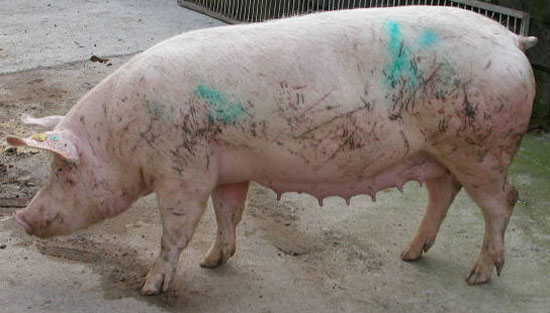In production systems sows are often kept in bigger groups than those produced in the wild: the small groups have a very stable social hierarchy, with a linear relation, while in bigger groups the relations become more complicated.
The number of conflictive interactions increases with the number of pigs up to six animals and then decreases with further increases in group size. There are two possible explanations for this behavior: firstly, that the animals from different subgroups ignore each other, and secondly, that in bigger groups the animals are more tolerant towards the other individuals. This is exploited in herds with big groups, with up to 100 or more sows.
In most herds, the sows are grouped after the ultrasound scan, during gestation, although there has also been success with groupings after lactation.
Even though the sows have lived together before parturition, the possibility that they will recognize each other and reproduce the same hierarchy is very small and there are three main reasons for this: a long time has passed since the dissolution of the group, some animals will not be present in the new group, and the nutritional state (the size) may have changed, giving opportunities to different sows. So the animals “renegotiate” the hierarchy. The fights begin immediately and this is inevitable, and man has the duty of influencing the levels of struggle, allowing the expression of this conduct but managing the new hierarchical state in the least traumatic way possible.

It should be noted that for small groups the minimum legal size may not be enough for the animals to escape the attacks, and the subordinate animals cannot demonstrate their submission.
Therefore, it is a good idea to offer a wide space, preferably in large pens, where an attacked animal can escape without any unnecessary aggression being caused by pressure from the dominant animals.
As the new groups develop, it is essential that the pen has a suitable size so that the groups can form correctly and can later be transferred to the final pen. The accommodation should be equipped with low walls to act as a refuge.
An empirical but very efficient strategy is to introduce the sows after having introduced a large boar: the interest in this animal will reduce the interaction between the sows.
It is a good idea to create dynamic groups that combine gestating sows in different stages of gestation, that are introduced in a continuous flow, where the animals can benefit from well defined zones in which the new groups can remain during the integration period with the main group.
A wide space for the animals allows them to move around and obtain resources without invading the personal space of other animals. Moreover, the weaker animals can show their submission by fleeing.
Administration and consumption of feed
In the first stages of gestation the quantity of feed provided is always rationed in order to favor the implantation of the embryo and to avoid an excessive fattening. The restriction of such an important resource (even economically) makes the social behavior a critical factor for management decisions, because the individual living space of the sows and gilts is regulated to allow each animal to feed separately.
The control of feed ingestion when the sows are allotted in groups is essential. The dominant animals will try to gain the best positions at the trough (facility of access, etc.). On the contrary, when the sows are fed sequentially at a single trough or in several spaces, as with electronic feeding, the concern will be to prioritize the turns of ingestion. The aggressions can provoke lesions and exclusion from feed for the weaker animals.

For these reasons, the electronic feeding stations should be suitably designed to allow the sows an untroubled feeding, correctly separating those that are waiting their turn or those that want to eat more.
Other systems, such as placing the feed on the floor, offer the sows less protection while they are feeding and increases competition. In order to maintain similar levels of ingestion it is necessary that the animals have a similar size and temperament. Some systems try to control competition between the gestating sows by an ad libitum administration. The use of diets with high levels of fiber allows the animals to ingest high volumes which achieves a high level of satiation. Another alternative is to allow occasional ad libitum access to feed (every five or seven days).
With systems where the competition for food is not well controlled, the dominant animals eat too much while the submissive animals don’t get enough.
Complying with the law with respect to the supply of fiber (to dispel hunger and the need to masticate) and of material for exploration and manipulation (straw, hay, peat, etc.), can be a valuable help to reduce the competition between the animals that feed concentrates once a day.
The ad libitum supply of ensilaged hay is also important, together with feed with a high energy content: it creates satiation, regulates intestinal flora, and moreover, it allows activities of manipulation and rooting.



